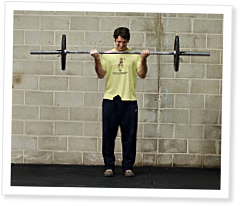
Spotted barbell biceps curls and white A-shirts, with just a hint of oil in place of sweat?
Men’s Journal might have rethought the opening image for “When to Fire Your Personal Trainer: 4 Red Flags.”
Nothing wrong with barbell curls, of course, but if you’re writing an article on identifying quality personal trainers, leading with an oiled-up bro-session curl shot does little to set the table and create an atmosphere of professionalism.
Then again, the image will indeed alert careful readers that the article is full of nonsense. Take, for example, this completely unfounded statement: “Certified Strength and Conditioning Specialist (CSCS) is the best certification.”
One wonders how author David Reavy came to that conclusion after it’s been shown that the company offering the CSCS credential—the National Strength and Conditioning Association—has no problem publishing false claims about competitors and can’t accurately instruct movement.
In the same section, the article suggests a trainer who provides nutrition advice isn’t helping the client but doing something shady: “If your trainer tries to give you nutritional or medical advice without the credentials, steer clear.”
Trainers who don’t give general nutrition advice are doing a disservice to their clients. Providing general nutrition advice is critical to client success, and good personal trainers have both the skills and the right to supply it. We’d suggest they also have a moral obligation to do so if they actually want to help their clients.
Trainers may not diagnose and treat medical conditions, and they may not offer prescriptions. But they’re poor trainers if they have not acquired the basic skills needed to give apparently healthy clients general nutrition advice so they can create healthy food habits that support their goals.
Any trainer who doesn’t won’t get real results, and any magazine that suggests trainers should avoid conversations about nutrition is a rag.
Without further ado, we’ll offer four red flags that suggest the magazine you’re reading isn’t worth your time:
1. Ridiculous Movement Instruction
Here’s a real workout: Have a scroll through “The Real Weight-Loss Workout,” also courtesy of Men’s Journal, and do 15 burpees every time you see an error in movement instruction or the accompanying pictures.
While you’re at it, keep in mind that this “weight-loss workout” contains little discussion of structure and has no precision whatsoever. Aside from “begin with sets of eight,” it’s just a list of exercises that are supposedly great for weight loss. It’s good to know the bench press can “elicit a decent calorie burn” in some way, but it’s clearly up to the reader to unravel the mystery.
Here are a few instructional gems:
—The dumbbell “snatch” that’s described is actually a hang snatch. Bonus: Leaving the ground by “a couple of inches”—inefficient in the snatch or clean—is apparently OK.
—The description of the push press is unintelligible, and the video demo actually shows the author doing push jerks by accident.
— The pictures of the deadlift set-up and second pull of the hang power clean contain significant errors any Level 1 CrossFit trainer could pick up instantly.
—Push-ups are considered “healthier than bench pressing,” though bench pressing is also recommended for its calorie-burning properties.
2. Shortcuts and Superstars
From Men’s Fitnesss: “Grow like a monster but train like a genius for more gains with less work.”
Any magazine that suggests an easy way to get “huge,” “shredded” or “ripped” should come with a package of magic beans that are 100 percent guaranteed to work 15 percent of the time.
Similarly, magazines glorifying unbelievable celebrity body transformations in short periods of time fail to mention that you will never be able to get the same results in the same time frame. Whether stars achieve their physiques with chemical shortcuts or a miraculous 24-hour-a-day commitment to a perfect training plan and diet, you will not look like a Marvel superhero in just a few months of training.
You can accomplish a lot in three months, by you can’t become Wolverine.
3. Placement
If you can pick up the magazine with one hand and a chocolate bar with the other, it’s likely you are reaching for the wrong fitness publication.
The magazines you’ll find in the impulse-buy section of any supermarket are generally rife with exaggerated claims (see above), get-fit-quick schemes, Photoshopped models and the kinds of inane, fatuous headlines you should consider insults to your intelligence: “How to Work out With Your Cat, as Explained by This Hot Male Model.”
You’re better off reaching for the comic to the right.
4. Gimmicks
Magazines full of “new and improved” fitness products should be called catalogs. If an amazing new product—usually in teal, purple, pink or orange—can supposedly revolutionize your workout, it’s time to put the magazine down and lunge your way to the nearest barbell.
The Shake Weight is perhaps the most well-known ridiculous fitness product, but successors to the ThighMaster pop up with alarming regularity in publications that aren’t worth your time. Most magazines will accept ads from anyone, but when you see an editorial piece featuring one of these novelty items, you know you’re in trouble. If the article suggests you’ll get amazing results simply by using the product, you’re heading toward Ab Glider territory.
What Else?
You’ve seen the magazines? What makes you fire a fitness magazine back on the rack? Post the offenses to comments.
No comments:
Post a Comment